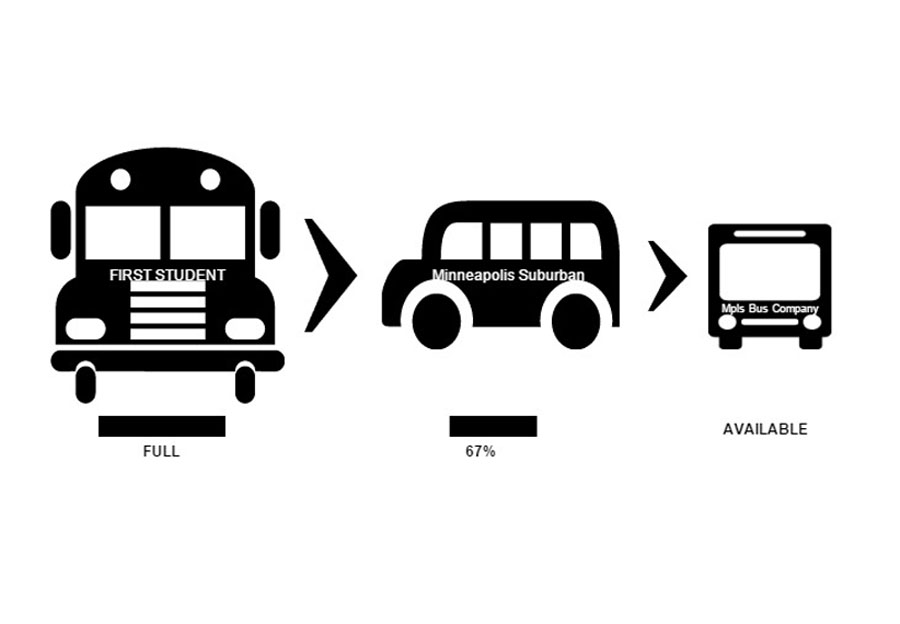Disorganization in busing causes problems for South sports
January 6, 2015
There’s an old joke, “you’re a bus driver, at the first stop, four people get on. At the second stop two people get off. At the third stop, seven people get off. At the fourth stop, everyone gets off… What was the name of the bus driver?” South High School’s sports bus system is just about as confusing as that so called “joke”.
In a nutshell, South uses three bus companies: First Student, Mpls Suburban, and Mpls Bus Company. Juggling three bus companies and having more than 35,000 students riding them is about as successful as it sounds. Once one company has booked all their buses, the school moves on to another company. While balancing communications between three bus companies, mishaps are inevitable. If a bus is not needed, it has to be canceled 48 hours in advance so the company can rebook the bus to another team or field trip.
This process began when school buses were taken away from high school students in the Minneapolis Public School district. The buses, originally removed for budgeting issues, were replaced with Go-To cards.
The Go-To cards, whose purpose is transporting students to and from school, or home from after school activities, don’t cater to sports teams. This means that while sports teams still need school buses, there are less resources going towards this bus system. While balancing communications between three bus companies, mishaps are inevitable.
Anyone at South who has participated in a sport can add to the consensus that the new bus system isn’t the most reliable. Ellen Demgen, sophomore on the varsity swim team, had a story to tell, “We had a meet at St. Kate’s one day and the bus was supposed to come at 3:45 but it ended up not coming until about 5 and we were stuck out in rain and then we ended up only getting about 15 minutes to warm up for the meet.” The lack of reliability is not only inconvenient but could be dangerous if the rain was replaced by subzero, Minnesotan weather.
South senior, and French foreign exchange student, Eloi Descamps is nordic skiing for the first time this year. “The team skied on Thursday but on Friday, there weren’t enough buses for us to go to Theodore Wirth [where the team skies],” commented Descamps. Without transportation the nordic ski team and other sports at South are forced to compromise on many things.
Assistant Athletic Director, Tony Stewart is the “bus guy” for South sports. Stewart works with three different bus companies and all the team coaches to make sure athletes get where they need to go.
“I try to be really polite with them,” Stewart said about communicating with the hectic bus companies. He explained that South has approximately nine buses to use and the companies have a large shortage of drivers. The secretaries at the companies will sometimes have to go out and drive buses, leaving the phones unanswered and the unfortunate chain of events continues.
Once Stewart manages to grab the necessary buses for the students, miscommunications continue to get in the way. On top of the shortage of bus drivers in the district, many of them have trouble with pick up and drop off communications. South sports teams and their coaches have waited for extended periods of time for a bus that was waiting on the opposite side of the school.
More problems arise when accommodating South’s combined teams. The swim team is combined with Washburn and Roosevelt, so buses make several stops to gather the whole team. Demgen remembered, “more than once the bus that was supposed to pick up swimmers from Washburn to go to practice just didn’t show up so we had to get someone else to go pick them up.”
Maneuvering around sports coaches being legally discouraged from driving their athletes in their own cars, and the mishaps concerning the buses, puts sports teams in a difficult position. “[During] cross country some people had to ride with the coach because there wasn’t enough room in the bus for people and the school wouldn’t supply another bus,” said sophomore Celina Barnett-Cashman; cross country runner, nordic skier and track runner. “A couple times it [the bus] hasn’t shown up and we’ve had to ride in people’s cars to the meet…”
If the option of more sports buses was available, South’s athletes would have the transportation needed to arrive places on time and wouldn’t have to scramble for last minute rides.
In response to being questioned about what actions are being made to remedy the dilemma, Stewart said he’s being “more proactive with coaches and getting bus requests in.” But the phone goes both ways. If more bus drivers were available, the busing system might run more smoothly.
As the bus companies and high schools adapt to the new system, hopefully busing in sports seasons to come will cease to be an issue.






